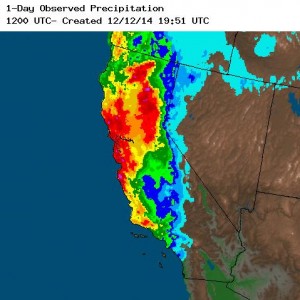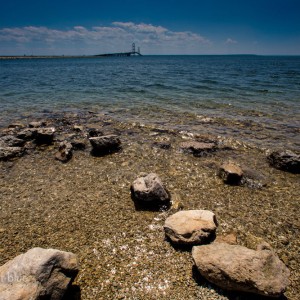Federal Water Tap, December 15: Budget Deal Holds Spending Steady on Water Infrastructure, Great Lakes
The Rundown
Budget deal preserves water infrastructure spending and includes guidelines for financing large dams abroad. NOAA scientists examine the causes of the California drought while the House passes drought legislation. The Ogallala Aquifer continues shrinking and ecosystems along the Mexico-U.S. border need comprehensive solutions. Seven rivers will get protected status and the Great Lakes region might get more restoration funding.
“Even if we get average precipitation, we’ll still be a year behind.” – U.S. Geological Survey hydrologist Michael Dettinger speaking with Circle of Blue about California’s deep moisture deficit.
By the Numbers
36 million acre-feet: Decline in the amount of water stored in the Ogallala Aquifer between 2011 and 2013, more than twice the annual flow of the Colorado River. The aquifer’s water level fell an average of 3.5 feet in Texas, the state with the largest average two-year drop. (U.S. Geological Survey)
25 percent: reduction in water use for front-loading commercial washers, as required by a new rule, which applies to washers manufactured after January 1, 2018. (Department of Energy)
Reports and Studies
Mexico-U.S. Border
Population growth, water diversions, agriculture, and energy development are among the many forces that are overwhelming federal efforts to revive exhausted ecosystems along the Mexico-U.S. border, according to the board that advises the president and Congress on environmental border issues.
In its sixteenth annual report, the Good Neighbor Environmental Board argues that both governments must undertake coordinated actions to improve rivers and wildlife habitat. The report uses case studies from three watersheds — the Colorado, Rio Grande, and Tijuana — to highlight success and failures.
News Briefs
Budget Deal
Two stalwart federal loan programs for drinking water and wastewater infrastructure will be funded at the same level as in 2014 — $US 907 million for the Drinking Water State Revolving Fund and $US 1.45 billion for the Clean Water State Revolving Fund.
The budget bill also includes instructions for financing large dams through international lenders such as the World Bank. The U.S. director of such institutions must evaluate five criteria (pg. 33) before voting to approve a large dam. The criteria are: an objective assessment of environmental and social risks, ecological sustainability, citizens’ rights, public oversight, and management.
California Drought
The three-year drought in California — the state’s worst in 1,200 years, according to a recent study — was caused by natural variations in the interaction between the ocean and the atmosphere, according to National Ocean and Atmospheric Administration researchers.
Critics of the study, however, pointed out that warmer temperatures caused by manmade climate change increased the severity of the drought. 2014 is on track to be the warmest in recorded history in California. Global average temperatures increased 1.5 degrees Fahrenheit since 1880, according to the Intergovernmental Panel on Climate Change.
Meanwhile, the U.S. House passed a bill to move more water to farmers in California’s San Joaquin Valley. The Senate, however, will not take up the bill, meaning the political tug-of-war for water will rest until Congress reconvenes next year with both chambers under Republican leadership.
Wild and Scenic Rivers
Seven rivers in five states will get federal protection as National Wild and Scenic Rivers. Appended to a 1,618-page defense spending bill are a few natural resources sections that grant special status to Oregon’s River Styx; segments of Washington’s Middle Fork Snoqualmie River, Pratt River, and Illabot Creek; the Missisquoi and Trout rivers in Vermont; and White Clay Creek in Delaware.
Data
The Obama administration released federal datasets on soils, streams, land cover, and biodiversity. The water resources section includes visualizations of data related to the California drought.
Great Lakes Funding
The U.S. House passed a bill that will provide $US 300 million annually for ecosystem restoration projects in the Great Lakes region. The funding was included in the $US 1.1 trillion budget deal.
On the Radar
China Trade Mission
The secretaries of energy and commerce will travel to China April 12 to 17 to promote low-carbon, high-efficiency cities. The mission was part of the China-U.S. climate agreement in October. All sorts of “smart” technologies will be on the agenda — from electrical grids to wastewater treatment.
Science Advisory Board
The National Oceanic and Atmospheric Administration is soliciting nominations for its science advisory board. Applicants should be skilled in the fields of meteorology, climate, or water resources. You can nominate yourself. Follow the link for application details.
Federal Water Tap is a weekly digest spotting trends in U.S. government water policy. To get more water news, follow Circle of Blue on Twitter and sign up for our newsletter.
Brett writes about agriculture, energy, infrastructure, and the politics and economics of water in the United States. He also writes the Federal Water Tap, Circle of Blue’s weekly digest of U.S. government water news. He is the winner of two Society of Environmental Journalists reporting awards, one of the top honors in American environmental journalism: first place for explanatory reporting for a series on septic system pollution in the United States(2016) and third place for beat reporting in a small market (2014). He received the Sierra Club’s Distinguished Service Award in 2018. Brett lives in Seattle, where he hikes the mountains and bakes pies. Contact Brett Walton






Leave a Reply
Want to join the discussion?Feel free to contribute!